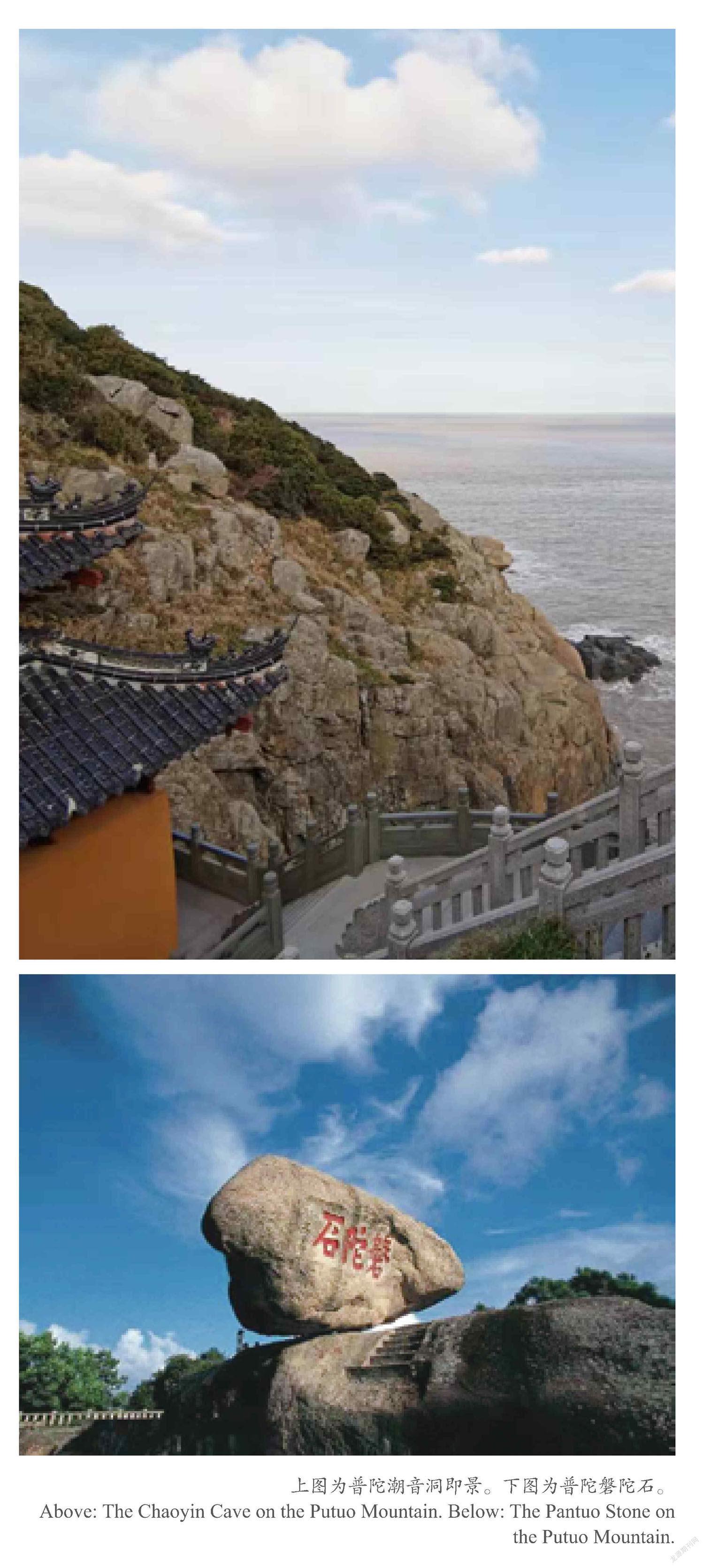文人雅士与普陀圣境
林上军 刘胜勇







“海上有仙山,山在虚无缥缈间”。说起中国四大佛教名山之一的浙江普陀山,在中国几乎家喻户晓。它坐落于著名的舟山渔港沈家门对岸,形似苍龙卧海,是舟山群岛众多岛屿中一个风景秀丽、梵音袅袅的小岛。岛屿面积约13平方公里,游客络绎不绝,疫情之前的2019年,普陀山朱家尖景区游客量超2000万人次。
其实普陀山不仅仅是因为佛教名山而出名,更因为千百年来,以海山之胜、大士之灵,吸引着无数文人雅士驻足、徜徉,形成了深厚的文化底蕴。据考证,宋代王安石、陆游、史浩,元代赵孟頫、吴莱,明代文徵明、屠隆、徐霞客、董其昌,清代全祖望、万言、袁枚、姚燮、俞樾、刘鹗,近代康有为、孙中山、郁达夫、吴昌硕,现代的巴金、丰子恺、刘海粟等文人墨客和名士雅士先后游山礼佛,留下了一帧帧诗书画卷、一段段传奇佳话。
陆放翁频游普陀释性情
作为宋代著名的爱国主义诗人、文学家、史学家,陆游以人生八十五个春秋创作了近万首诗。陆游(1125-1210年),字务观,号放翁,越州山阴(今浙江绍兴)人。由于才华出众、为人正直,陆游仕途坎坷。
也许是向往普陀胜景,也许是为排遣郁闷心情,陆游曾前后四次莅临普陀山。宋绍兴二十四年(1154),参加礼部考试,因其名列宰臣秦桧的孙子秦埙之前,被秦桧除名。是年,他与几位同窗赴普陀山释放心情。
淳熙四年(1177),时任提举常平茶盐公事的陆游,再次来到普陀山,住了10余日。他在普陀山题海山壁间诗《登山望旭》云 :“海上乘云满袖风,醉扪星斗蹑虚空。更知壮观非尘世,半夜鲸波浴红日。”抒发了自己壮心不已的抱负。
淳熙七年(1180),他以擅权罪名被罢职还乡闲居山阴。淳熙十年(1183)6月,陆游从绍兴来到普陀山,这次他在山上仅游了半日。“壮志蹉跎雪满头,久将余日付沧洲……公卿忧责如山重,肯信人间有放翁!”从诗中可知,他到普陀山,不是消极懈怠,而是有所寄托的。这次他在山上留下了《海山》和《梦海山壁间诗不能尽记其意追补》两首诗,抒发了自己的感想。
其中《梦海山壁间诗不能尽记其意追补》这样写道:碧海无风镜面平,潮来忽作雪山倾。金桥化出三千丈,闲把松枝引鹤行。
开禧三年(1207)秋,八十高龄的陆游重游普陀山。因家居时养生有术,他依然耳聪目明,身似游云野鹤,据说当时还健步登上普陀山最高峰佛顶山,与小庵高禅师把茶问盏,诉说心事。他进普陀山宝陀观音寺圆通殿,游千步沙,并赋《千步沙观潮》《记九月二十六日夜》两诗。两诗都是描写风景名胜、山水景物,以写景抒情为主。语言平实通俗、明白如话,表现手法细腻传神,诗歌意境平和恬淡。
王鲁彦夜宿普陀听潮音
一篇《听潮的故事》,让近代作家王鲁彦的名字印在许多中国人的脑海中,因为这篇文章收进了中学语文课本。而这篇散文的灵感就来自普陀山岛。
王鲁彦(1901~1944),现代小说家。原名王衡,又名王返我,字忘我,浙江镇海人。 长期从事教育和编辑工作。1929年7月,王鲁彦偕新婚妻子覃英,应作家郁达夫及其妻子王映霞之邀,于当月25日抵达普陀山。同行的还有著名作家楼适夷、著名诗人任钧等。
郁达夫(1896~1945),中国现代著名小说家、散文家。浙江富阳人。早年留学日本,1927年定居上海,曾参加“左联”。1933年迁居杭州。抗日战争期间在南洋从事抗日救亡宣传活动。
他们一行先住在普陀山天福庵里。他们中只有任钧躲在庵里埋头写中篇小说《爱与仇》,其他人每天游山玩海,过得极为浪漫悠闲。郁达夫去潮音洞听潮音,站在礁石上,见浪涛轰鸣而下,即兴赋诗《游普陀作》:山谷幽深杖策寻,归来日色已西沉。雪涛怒击玲珑石,洗尽人间丝竹音。
几天后,王鲁彦夫妇与郁达夫等转移至朝阳庵中下榻。朝阳庵位于普陀山千步沙和白步沙之间,凭海临风,白天在房间推窗望出去气象万千、心旷神怡;晚上,枕涛而眠,天籁之音不绝。
作为现实主义作家的鲁彦,他正是带着由于时势变化而产生的不同寻常的心情来到四面环海的普陀山避暑。他住在濒临大海的庵房里,日夜倾听着海潮的声响。当海潮停落之时,恬静优美;而当其暴涨之时,则又雄浑壮阔。
鲁彦非常喜欢听海潮的声音,他常常一个人走到门外听潮声。海潮起伏,潮声在不同的时间有不同的声音。鲁彦面对澎湃的海潮,耳为所感,心为所动,海潮与心潮并起。
普陀山的海潮有其独特的振聋发聩的魅力,这是其他地方海潮所不可比拟的。第二年,鲁彦与覃英去了厦门鼓浪屿海边,那里也有一望无际的海,同样也是听潮,但感觉完全不一样。鲁彦后来把与妻子在普陀山听潮的那段经历,写就一篇借景抒情的优美散文《听潮的故事》。他抓住大海落潮、漲潮初起和涨潮达到高峰时声音情态的不同、感受的不同,通过大海的变化,直抒胸臆,描绘了海睡图、海醒图、海怒图,表达对大海的溺爱之情。
在王鲁彦的耳中、心里,海天佛国普陀山的潮音是如此精彩绝伦:如战鼓声、金锣声、呐喊声、叫号声、啼哭声、马蹄声、车轮声、机翼声掺杂在一起,像千军万马混战起来……
书画家摩崖石刻留墨印
在普陀山普济寺旁,有一处摩崖石刻,上书“震旦第一佛国”,为明朝登莱总兵张大可(字观甫)所书,写出了当时普陀山香火旺盛的壮观景象。 摩崖石刻是普陀山深蕴文化内涵的人文景观之一,现普陀山上存160余条摩崖石刻,有的为元代赵孟頫所题,而大多是明清及以后的题书,有明董其昌、侯继高、何汝宾,清康熙、雍正、吴昌硕、康有为,近代郭沫若、赵朴初等。其中可考刻石有114处,其中明代25处、清代10处、近代30余处。
2011年,普陀山新的文化景观被列入省级文保单位。由普济寺周边的达摩峰西摩崖石刻、西天门元代石刻、海岸牌坊、大乘庵、文昌阁、兴善堂、积善庵和法如庵等八处文物古迹整合为普陀山新的文化景观,据《普陀山大辞典》记载,达摩峰上由赵孟頫书写的直径达1.4米的“瀛洲界”三个大字,是赵孟頫先用盛米的小畚箕,将米一畚箕一畚箕地撒在纸上,形成“瀛洲界”三字,然后用墨笔勾定。
五朝恩賜无双地,四海尊崇第一山。关于历代文人雅士与普陀圣境的故事,千百年来可谓不胜枚举。
千秋香火真如地,万国梯航大士家。如今,普陀山已经成为五大洲信众和游客向往的朝山揽胜之地,一年四季游人如织,香客如潮。美丽的自然风景和浓郁的人文底蕴、佛教气息,使它蒙上一层神秘的色彩。进入新时代,普陀山与时俱进,书写着崭新的人文景观,延续着悠久历史的精彩文脉。
The Scared Putuo Mountain
By Lin Shangjun Liu Shengyong
The Putuo Mountain, one of the four sacred Buddhist mountains in China, is known to almost every household in the country. Sitting across the Shenjiamen Port, a famous fish port in Zhoushan city, Zhejiang province, it emerges from the sea like a crouching emerald dragon, and stands out among the Zhoushan Archipelago as a dainty island with rich Buddhist culture. Its 13 or so square kilometer stretch is usually thronged with tourists: in 2019, the Zhujiajian- Putuo Mountain Scenic Area received over 20 million visitors.
However, Putuo Mountain’s cultural reputation is not built on Buddhism alone. For thousands of years, visiting literati and celebrities have been captivated by its fascinating sea and mountain views and they wrote affectionately about this place in the form of poetry and articles, and recreated its beauty through paintings. According to historical records, such visitors include Wang Anshi, Lu You and Shi Hao from the Song dynasty (960-1279), Zhao Mengfu and Wu Lai from the Yuan dynasty (1206-1368), Wen Zhengming, Tu Long, Xu Xiake and Dong Qichang from the Ming dynasty (1368-1644), Quan Zuwang, Wan Yan, Yuan Mei, Yao Xie, Yu Yue, Liu E from the Qing dynasty (1616-1911), as well as contemporary Kang Youwei, Sun Yat-sen, Yu Dafu, Wu Changshuo, Ba Jin, Feng Zikai and Liu Haisu.
As a famous patriotic poet, writer and historian, Lu You (1125-1210) wrote nearly 10,000 poems during his lifetime. Born in Shanyin, Yuezhou (nowadays Shaoxing, Zhejiang), Lu had a career path that twisted and turned because of his outstanding talent and integrity.
Lu visited the Putuo Mountain for four times. The first time was in 1154, after he was framed by Qin Hui (1090-1155), the notorious traitor, and failed in an examination held by the Ministry of Rites. In 1177, Lu revisited here as an official and stayed for ten days. During his stay, he wrote a poem titled “Dengshan Wangxu” (“Ascending the Putuo Mountain and Watching Sunrise”), crying out his unrewarded ambition. He came back for his third visit in 1183 and stayed for only half a day. Three years before, he was removed from office and returned to Shaoxing with unfulfilled aspirations, which he weaved into the two poems composed during his half-day visit at the Putuo Mountain.
In the autumn of 1207, the then 80-year-old Lu came to Putuo for the fourth time, and he was still in a very good shape, brilliant and brisk as ever. It is said that he even climbed to the top of Foding Mountain, Putuo’s highest peak, drank tea while conversing with a Buddhist monk, and visited several temples and other scenic spots. For the fourth visit, Lu wrote another two delicate, peaceful poems on the local landscape in a plain and communicative style.
Wang Luyan (1901-1944) is a Chinese contemporary writer who became well-known by an article selected into a Chinese textbook. The article was titled “Tingchao de Gushi” (Story of Listening to Tides), and it was inspired by the Putuo Mountain.
Wang Luyan is a modern novelist. He was born in Zhenhai, Zhejiang, formerly known as Wang Heng and Wang Fanwo with the courtesy name Wangwo. Wang has been long engaged in education and editing. In July 1929, Wang and his newly married wife Tan Ying reached the Putuo Mountain at the invitation of the famous writer Yu Dafu and his wife Wang Yingxia, accompanied by the writer Lou Shiyi and the poet Ren Jun, who were also reputable. They were a romantic, laid-back crowd.
As a realistic writer, Wang was mindful of the changing society and decided to spend some summertime at the Putuo Mountain, listening to the sound of the tides. He loved the sound of the tides here, which varied at different times, and was deeply attracted to their unparalleled charm. Later, he wrote his tide-admiring experience into his famous article, where the varying sound and mood of the sea rising and falling were captured fondly.
Next to the Puji Temple on the Putuo Mountain, there is a cliff inscription carved by Zhang Dake, a Ming dynasty commander, which proclaimed Putuo as the foremost Buddhist ground in China, showing the popularity of the Putuo Mountain for Buddhist worshippers back then. On the Putuo Mountain, the cliff carvings are one of the humanistic landscapes with deep cultural connotations. More than 160 cliff carvings could be found here on the Putuo Mountain, some of which were inscribed by the Yuan dynasty painter and calligrapher Zhao Mengfu (1254-1322), while most of them were inscribed in Ming, Qing and later dynasties. Among them, 114 can be traced to their authors, of which 25 were from the Ming dynasty, 10 from the Qing dynasty and more than 30 from the modern times.
In 2011, the new “Putuo Mountain Cultural Landscape” was listed as a provincial cultural preservation unit, which includes eight cultural relics and monuments around the Puji Temple.
Throughout history, the stories between the celebrities and the holy land of Putuo are countless. The beautiful natural scenery combined with rich humanistic and Buddhist culture has made the sacred mountain even more mysterious. Now the Putuo Mountain is entering a new era, and it will keep pace with the times while renewing its humanistic landscape.

